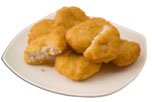As a popular product in Western-style fast food, formed chicken nuggets have gained significant consumer attention, and more companies are entering this production field. This guide provides a detailed look into the key process points in producing formed chicken nuggets.
Main Types of Formed Chicken Nuggets:
- High Meat Content: Nuggets from McDonald's, KFC, and Tyson are characterized by a higher meat content.
- Lower Meat Content: Many products on the market contain lower meat ratios.
To produce nuggets that not only avoid imitating others but also offer:
- Higher Quality compared to competitors.
- Lower Costs compared to competitors.
It is essential to control the following points:
1. Ingredient Proportion: Use a balanced mix of chicken breast, chicken skin, and additives.
2. Mixing Temperature: Keep the temperature around -5°C. Lower temperatures allow for more binding agents, reducing costs.
3. Forming Pressure: High pressure during forming helps create a denser structure and a more uniform shape.
4. Frying Temperature: Aim for a high frying temperature, up to 200°C. This ensures that the batter quickly sets, minimizes oil damage, and increases output.
5. Oil Management: Proper oil treatment reduces costs and maintains consistent nugget quality.
Optimal Equipment Selection:
1. Non-Vacuum Bowl Cutter: Choose a machine with a capacity of at least 100 liters or a high-end grinder with holes smaller than 3 mm for mincing chicken skin.
2. Vacuum Cooling Mixer: Prefer a mixer with bottom liquid nitrogen or CO₂ injection. Note that only one-third of the mixer's volume is used; for 800 kg/hour production, a 2,000-liter mixer is required.
3. Forming Machine: Use a pull-out plate or drum-type forming machine for efficient nugget shaping.
4. Coating and Frying Line: Use a battering machine, pre-dusting machine, breading machine, fryer, and spiral freezer to ensure complete processing.
5. Batter Temperature: Maintain batter temperature between 0–4°C for optimal coating and to prevent peeling.
Production Scale Recommendation: A production line capacity of around 1 ton per hour is optimal for easy management and efficiency.
